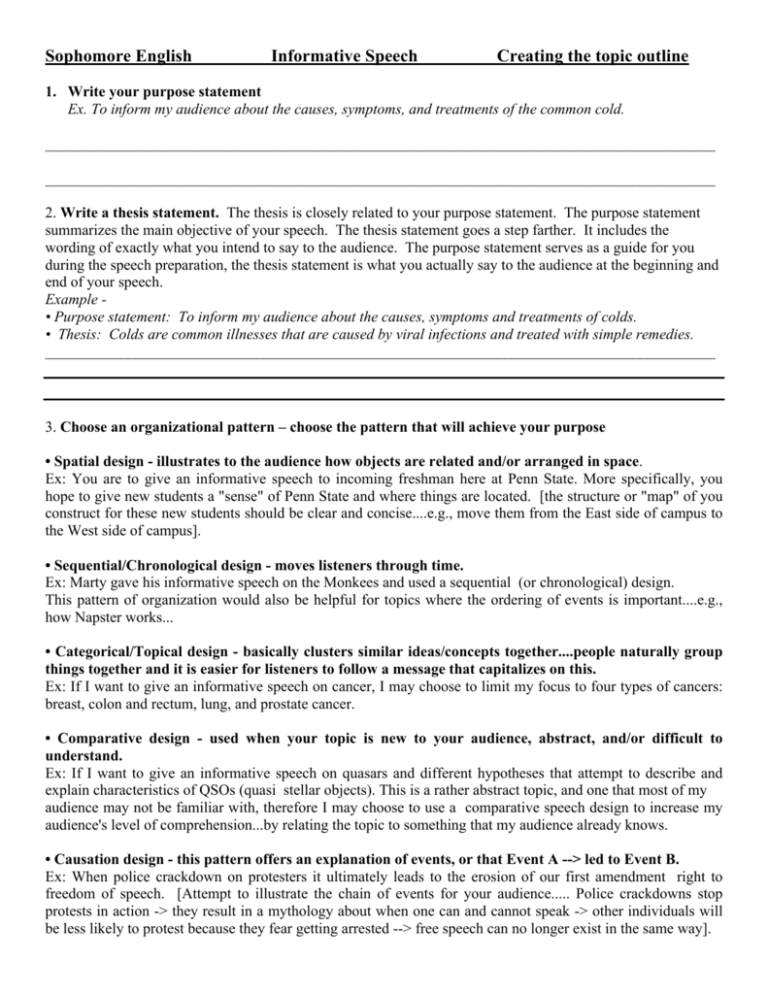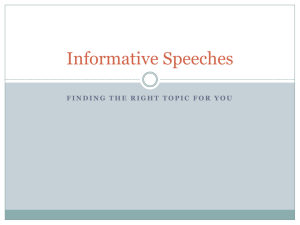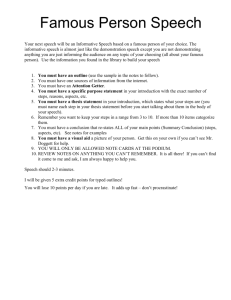Creating the topic outline
advertisement

Sophomore English Informative Speech Creating the topic outline 1. Write your purpose statement Ex. To inform my audience about the causes, symptoms, and treatments of the common cold. _________________________________________________________________________________________ _________________________________________________________________________________________ 2. Write a thesis statement. The thesis is closely related to your purpose statement. The purpose statement summarizes the main objective of your speech. The thesis statement goes a step farther. It includes the wording of exactly what you intend to say to the audience. The purpose statement serves as a guide for you during the speech preparation, the thesis statement is what you actually say to the audience at the beginning and end of your speech. Example • Purpose statement: To inform my audience about the causes, symptoms and treatments of colds. • Thesis: Colds are common illnesses that are caused by viral infections and treated with simple remedies. _________________________________________________________________________________________ 3. Choose an organizational pattern – choose the pattern that will achieve your purpose • Spatial design - illustrates to the audience how objects are related and/or arranged in space. Ex: You are to give an informative speech to incoming freshman here at Penn State. More specifically, you hope to give new students a "sense" of Penn State and where things are located. [the structure or "map" of you construct for these new students should be clear and concise....e.g., move them from the East side of campus to the West side of campus]. • Sequential/Chronological design - moves listeners through time. Ex: Marty gave his informative speech on the Monkees and used a sequential (or chronological) design. This pattern of organization would also be helpful for topics where the ordering of events is important....e.g., how Napster works... • Categorical/Topical design - basically clusters similar ideas/concepts together....people naturally group things together and it is easier for listeners to follow a message that capitalizes on this. Ex: If I want to give an informative speech on cancer, I may choose to limit my focus to four types of cancers: breast, colon and rectum, lung, and prostate cancer. • Comparative design - used when your topic is new to your audience, abstract, and/or difficult to understand. Ex: If I want to give an informative speech on quasars and different hypotheses that attempt to describe and explain characteristics of QSOs (quasi stellar objects). This is a rather abstract topic, and one that most of my audience may not be familiar with, therefore I may choose to use a comparative speech design to increase my audience's level of comprehension...by relating the topic to something that my audience already knows. • Causation design - this pattern offers an explanation of events, or that Event A --> led to Event B. Ex: When police crackdown on protesters it ultimately leads to the erosion of our first amendment right to freedom of speech. [Attempt to illustrate the chain of events for your audience..... Police crackdowns stop protests in action -> they result in a mythology about when one can and cannot speak -> other individuals will be less likely to protest because they fear getting arrested --> free speech can no longer exist in the same way]. Name of organizational pattern: ________________________________________________________________________ 4. Write a topic outline – a brief outline of the main point and sub points of the speech. You should not include actual pieces of evidence in this outline, just the ideas you will be discussing. Guidelines for the topic outline a. Put the following information at the top of the page – purpose, thesis, pattern of organization. b. Roman numerals are used to indicate main points. c. All main points should be full sentence. d. Capital letters are used to indicate sub points e. All outlines must be word-processed. Sample topic outline Purpose: To inform my audience about the causes, symptoms, and treatments of the common cold.) Thesis: Colds are common illnesses that are caused by viral infections and treated with simple remedies. Organization: Categorical I. The common cold is a viral infection. A. Viral infection B. Symptoms of cold C. Contagiousness of cold II. While the cold can’t be cured, remedies can be used to ease some of the symptoms. A. Remedies of the past. B. Modern remedies. C. Vitamin C as a remedy







